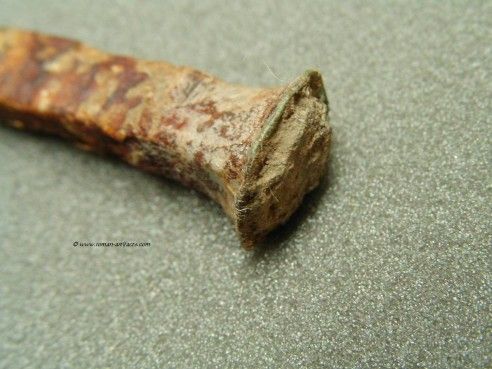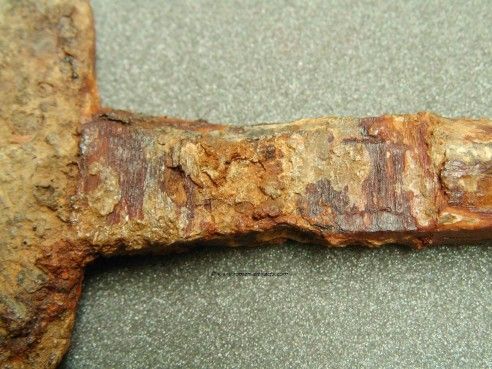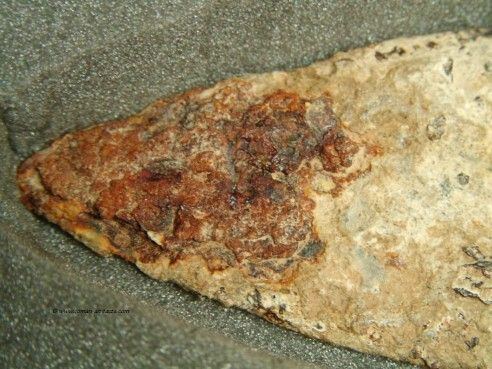Legionary Gladius / Semi-Spatha
Dec 4, 2013 16:24:54 GMT
Post by Jack Loomes on Dec 4, 2013 16:24:54 GMT





Date Acquired: 2004
Location Discovered: Xanten near Rhine River
Material: Iron with some wood impressions
Dimensions
Total Length = 66.5cm
Blade Length = 50.00cm
Blade Width = 4.9cm near the hilt, 4.2cm. then 3.8cm and finally 3.5cm near the end.(tapering whole length)
Brass washer: 14mm square
Based on the grip corrosion markings the width of the handle parts can be determined.
Pommel: 33.35mm thick
Grip: 98.26mm
Guard plate: 23.33mm
Roman Empire 3rd to late 4th Century AD
Description
A Roman iron sword with a largely solid blade that was partially covered in what is believed to salt and/or lime deposits and encrustations. Restoration & conservation has been completed, revealing what is believed to be wood impressions over the length of the blade on both sides. The heavily corroded iron was stabilized and large portions of the encrustations removed. The majority of these deposits are believed to be maintaining the stability of the sword. There are clear indications of where the pommel piece was as well as where the guard once existed(indicated by the perpendicular impressions on the hilt). The rectangular bronze washer is still present at the end of the hilt, meant to divide the pommel from the butt end of the iron hilt. This end could then be hammered down to solidly lock all the grip sections into place. Restoration work was completed to secure a crack in the hilt (indicated by the visible fibers at the end of the hilt).
Identification of the Sword
This sword has been somewhat difficult to directly identify, although it certainly is Roman, the exact period is still not 100%. Through out the Roman period especially after the 2nd Century, the Roman army lost some of its consistency and there were many local variants of swords and equipment. This is not unusual when considering the empire spanned from Britain to Jerusalem. This sword does fit somewhere within a certain period and can be ruled out of most centuries. The late Roman historian Flavius Vegetius Renatus describes the army of the 4th Century carrying a "semi-spatha" which simply a shorter version of the longer Spatha. This semi-spatha may have acted as a secondary weapon.
The following is a step by step analysis of why the date range was picked.
- The ogival shape of the point(as opposed to triangular) makes it most likely later than 200AD(it's not of the pompeii/republican type)
- The blade length does make it a short sword. Far shorter than the more dominant Spatha of that period would have been(they were around 60cm to 100cm in blade length).
- It doesn't however fit the 3rd Century AD Kunzing type short sword find, as it is too long (thier blade length was between 23-39cm)
- It also doesn't fit into the two classifications styles of the period."Staubing/Nydam"(blade length of 65-80cm with a blade width of 4.4cm max, tapering blade ) and the "Lauriacum/Hromowka" (blade length of 55-65cm with a width of 6.2cm-7.5cm, triangular point and parallel edges)
- The blade width coupled with the tappering style and length does however make it fit somwhere in between the two clasification systems above, which is allowed. The hilt is ready to serve the classic 3 part Roman design. The metal plate then the wooden/or bone hilt piece, grip section(with possible grip impressions) and then finally the pommel. This three step hilt system is consistent with other Roman swords.
- There are no Fuller/grooves visible down the center of the blade, normally consistent with 3rd Century spatha/short swords.
Late Roman Classification
The blade matches the general shape of the 4th Century find at Koln, although it is slightly shorter and narrower (Koln L: 720mm W: 52mm). The sword at Koln had a niello-inlaid disk chape (similar in style to this example) Another find from the Alzey also dated to the late 3rd early 4th Century is actually of similar length (470mm). Both of these swords are also of the tapering type.
Source: www.roman-artifacts.com/gladius_spatha%20&%20components/legionary%20gladius%20or%20semispatha/gladius%20or%20semispatha.htm

.png?width=1920&height=1080&fit=bounds)